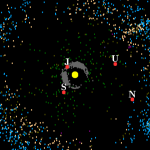Oddball dwarf planet Haumea has a ring0
- From Around the Web, Space
- October 13, 2017
It’s the first object past Neptune in the solar system known to have debris circling it

It’s the first object past Neptune in the solar system known to have debris circling it

The plane of our solar system is warped in the outer reaches of the Kuiper Belt, suggesting the presence of an unknown Mars-to-Earth-mass planetary object far beyond Pluto—but much closer than Planet Nine.

An unknown Mars-to-Earth-mass planet may lurk in the outer reaches of the Solar System.

a UCLA-led team of scientists reports that it has discovered the existence of a white dwarf star whose atmosphere is rich in carbon and nitrogen, as well as in oxygen and hydrogen, the components of water.

NASA’s New Horizons spacecraft completed a short propulsive maneuver Wednesday to refine its track toward a New Year’s Day 2019 flyby past 2014 MU69, a Kuiper Belt object (KBO) some 4 billion miles (6.4 billion kilometers) from Earth.

NASA’s New Horizons space probe has been busy the past few years. After traveling roughly 4.67 billion miles to reach the dwarf planet Pluto’s system in July of 2015, the spacecraft is now moving on to its next target, an object discovered in the Kuiper Belt by the Hubble Space Telescope in June of 2014 and dubbed 2014 MU69.

Though ancient cultures often saw comets as harbingers of doom, the cosmic “dirty snowballs” are now viewed as important objects that could help scientists learn more about the early evolution of the solar system.

Since it fell sixteen years ago, scientists have been looking closely at the Tagish Lake meteorite, and it is made up of different materials from other meteorites.

Planet 9, the hypothetical planet that lurks at the outskirts of our solar system, may be coming into focus in the near future, thanks to the efforts of scientists around the world. New theories are emerging about the potential location and even the possibility that there are two or more as yet undiscovered planets orbiting the sun beyond Neptune.

Models suggest cosmic rays can trigger reactions in interstellar ice balls causing formation of more complex molecules



